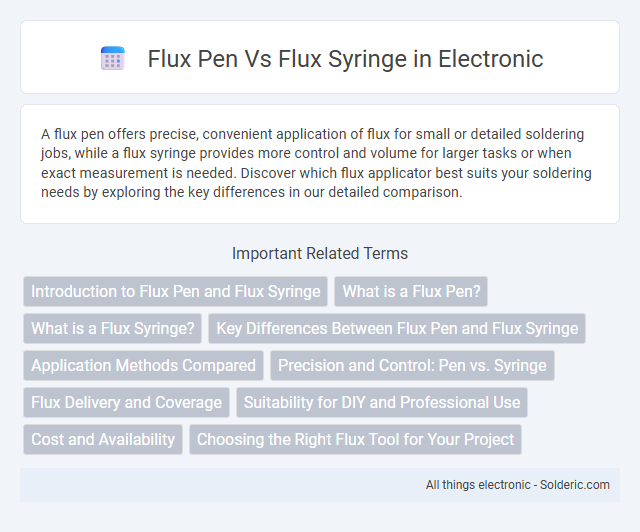A flux pen offers precise, convenient application of flux for small or detailed soldering jobs, while a flux syringe provides more control and volume for larger tasks or when exact measurement is needed. Discover which flux applicator best suits your soldering needs by exploring the key differences in our detailed comparison.
Comparison Table
| Feature | Flux Pen | Flux Syringe |
|---|---|---|
| Application | Precise, controlled flux application for small areas | Bulk flux dispensing, ideal for larger surfaces |
| Ease of Use | Simple, pen-like handling | Requires careful pressure control |
| Flux Volume | Limited, ideal for fine work | Higher volume, suited for mass soldering |
| Precision | High precision for detailed tasks | Lower precision, for broader application |
| Refillable | Often refillable or disposable | Mostly refillable |
| Cost | Moderate price per unit | Generally more cost-effective for volume use |
| Common Use Cases | PCB repair, delicate electronics soldering | Manufacturing, bulk soldering tasks |
Introduction to Flux Pen and Flux Syringe
Flux pens offer precision and convenience for applying soldering flux, ideal for intricate electronic work, while flux syringes provide controlled dispensing suitable for larger or bulk applications. Both tools deliver essential flux that cleans and prepares metal surfaces for soldering, enhancing bond strength and conductivity. Your choice depends on project scale and accuracy requirements, with pens favored for fine detail and syringes for volume.
What is a Flux Pen?
A flux pen is a precision tool designed for applying flux to electronic components during soldering, providing controlled and mess-free distribution. Unlike flux syringes that dispense larger volumes, flux pens allow for accurate application on small, delicate areas, reducing the risk of excess flux residue. You benefit from enhanced solder joint quality and cleaner work with a flux pen's user-friendly design.
What is a Flux Syringe?
A flux syringe is a precise dispensing tool designed to apply controlled amounts of flux during soldering or electronic repair, ensuring cleaner joints and reducing excess residue. It allows you to inject flux directly onto circuit boards or components with accuracy, making it ideal for delicate or intricate soldering tasks. Compared to a flux pen, the syringe offers better control over volume, which is essential for consistent and high-quality results.
Key Differences Between Flux Pen and Flux Syringe
Flux pens offer precise, controlled application ideal for small or intricate soldering tasks, while flux syringes provide larger volumes suitable for broader coverage or repetitive use. The pen's fine tip enables easy handling and minimizes waste, making it perfect for delicate electronics work. Your choice depends on the scale and precision required, ensuring efficient flux application tailored to your soldering project.
Application Methods Compared
Flux pens offer precise and controlled application ideal for small or detailed soldering tasks, allowing you to apply flux directly without excess waste. Flux syringes provide a larger volume suitable for covering bigger areas or multiple joints quickly, making them efficient for batch work or reflow processes. Your choice depends on the scale and precision required for the soldering application.
Precision and Control: Pen vs. Syringe
Flux pens offer superior precision and control for small, intricate soldering tasks thanks to their fine-tipped applicators, enabling targeted flux application without excess spillage. Flux syringes provide greater volume and flow control for larger areas but may lack the pinpoint accuracy necessary for delicate electronics work. Choosing between a flux pen and syringe depends on the task size, with pens favored for precision and syringes preferred for bulk application.
Flux Delivery and Coverage
Flux pens provide precise, controlled flux delivery ideal for small or detailed soldering tasks, minimizing waste and mess. Flux syringes offer larger volumes for broader coverage, making them suitable for extensive PCB work or reflow soldering. Selecting between the two depends on the project scale and the required flux application method to ensure optimal solder joint quality.
Suitability for DIY and Professional Use
Flux pens offer precise application ideal for small-scale DIY electronics projects, giving users control and ease when soldering delicate components. Flux syringes provide a higher volume of flux suitable for professional use, especially in manufacturing or repair environments where large quantities are required for thorough coverage. Choose your flux tool based on the scale and precision needed in your work to ensure optimal soldering results.
Cost and Availability
Flux pens offer a convenient and affordable solution, typically priced lower than flux syringes, making them ideal for small-scale soldering tasks. Flux syringes, while slightly more expensive, provide larger volumes suitable for frequent or industrial use and are widely available through electronics suppliers. Your choice depends on balancing cost-effectiveness with the quantity and consistency of flux required for your projects.
Choosing the Right Flux Tool for Your Project
Choosing the right flux tool depends on the precision and scale of your project; flux pens offer controlled application ideal for small, delicate electronics, while flux syringes provide larger quantities suited for extensive soldering tasks. Your decision should consider the surface area and complexity of your components, ensuring optimal flux distribution to enhance solder joint quality. Selecting the appropriate flux tool improves efficiency and reduces waste, leading to better results in your soldering projects.
flux pen vs flux syringe Infographic

 solderic.com
solderic.com